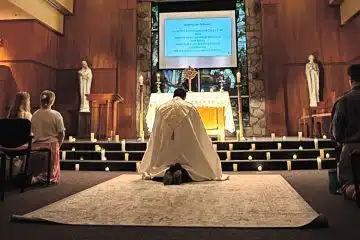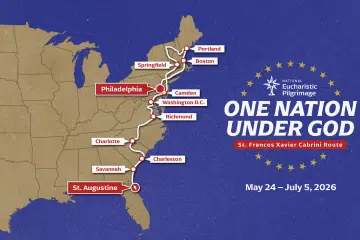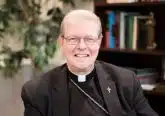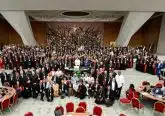SYNODALITY IN THE CHURCH AND OF THE CHURCH
This article is part of a series from Father Earl Fernandes exploring Families of Parishes. Click the links below to find other articles in the series.
The Church as the Family of God
Families of Parishes as Evangelizing Communities
Being a Synodal Church
Synodality Walking with Christ, The Holy Spirit and the Virgin Mary
Families of Parishes Discernment and Co-Responsibility
In this series, we have attempted to ground our understanding of the Beacons of Light initiative in the Church as the Family of God. As the Family of God, we journey together in a synodal way, imitating the walking together of the Trinity. This “walking together” requires walking also with Christ, to whom we unite ourselves in the Eucharist. The whole Church is guided also by the Holy Spirit, who calls us together and leads us along our journey. It was the Spirit who overshadowed Mary at the conception of Jesus and who descended upon the Apostles when they were in prayer with Mary at Pentecost.
Trusting in the power of Christ and His Spirit and taking confidence in the Virgin Mary, the People of God in the Archdiocese of Cincinnati prepare for the journey that lies ahead. In speaking of the Church as a family that journeys together, we can speak of synodality in the Church and of the Church.
SYNODALITY IN THE CHURCH
Synodality in the Church refers to the divine life in which members of the Church share in the synodality of the Trinity. This sharing happens in a variety of ways, most prominently through the liturgy and sacraments, in which the whole People of God journey toward the heavenly Jerusalem, with Church members exercising their diverse charisms and ministries. Ecclesial synodality takes on flesh in institutions (diocesan synods, parish finance councils, pastoral councils, etc.) when those structures are animated by the Risen Lord and attentive to what the Spirit says.
These “institutions” are extremely important in Beacons of Light as “Families of Parishes” develop pastoral plans. Difficult decisions will need to be made about how to work together, finances, schools and facilities. The focus cannot be on clinging to the past or holding on to power; rather, the focus must be on the mission of evangelization and discovering what the Risen Lord and the Spirit have prepared.
THE RELATIONSHIP OF THE DISCIPLES TO GOD
Synodality in the Church is also related to koinonia, which refers to the new relationship that disciples have with God and one another. The Church’s communion is revealed as the Trinity’s initiative, rather than a result of the will of people who associate for reasons of convenience, common interests or business.
Koinonia refers to a spiritual union and to a visibly operating concordance of hearts and minds (Acts 2:42), beginning with baptism through which one is incorporated into the life of Christ and the Church, forming a societas. Koinonia is an unconditional gift from God who desires that all share in His Son’s life and share solidarity with one another; it is also a spiritual work involving sharing in the suffering and consolation of others (cf. Rom. 12:13; 2 Cor. 1:5-7; Phil. 3:10; 4:14) and performing concrete works of charity (cf. Rom. 15:26; 2 Cor. 8:4; 9:13; Gal. 2:9; Phil. 1:5; Phil. 6).
Journeying together as a family is one of the most visible and meaningful forms of ecclesial communion, involving many modes of participation in the Church. If communion is a sharing in the Church’s faith and mission, this journeying is the sign and fulfillment of that communion.
Of course, there will be resistance from those unwilling to, or fearful of, change. Patience is necessary. Each person and each parish within a Family must ask: Am I a bridge to unity within the parish or am I a barrier? Are we truly searching for the way forward or serving as obstructions? How are we becoming an evangelizing community?
SYNODALITY OF THE CHURCH
In our journey, the synodality of the Church refers to the Church that is like a “sacrament or sign and instrument both of a very close-knit union with God and of the unity of the whole human race” and that “desires now to unfold more fully to the faithful of the Church and to the whole world its own inner nature and universal mission” (Lumen Gentium, 1). It describes the Church’s journey with all of humanity in history.
This way of being is properly understood not as an expression of power but as a representatio ecclesiae, whose authority comes from Christ for the service of humanity. What type of face do we as a Church want to show forth? Can we be a Samaritan Church? Precisely because the Archdiocese of Cincinnati offers so many services through schools, hospitals, Catholic Charities and the like to so many non-Catholics, we must be conscious of our responsibility toward those in the wider community whom we serve. A focus on service rather than power can help us discern the way forward in promoting the common good and bringing the joy of the Gospel to those around us.
 Father Earl K. Fernandes is the pastor of St. Ignatius of Loyola Church in Cincinnati and holds a doctorate in moral theology from the Alphonsian Academy in Rome.
Father Earl K. Fernandes is the pastor of St. Ignatius of Loyola Church in Cincinnati and holds a doctorate in moral theology from the Alphonsian Academy in Rome.
This article appeared in the December 2021 edition of The Catholic Telegraph Magazine. For your complimentary subscription, click here.













